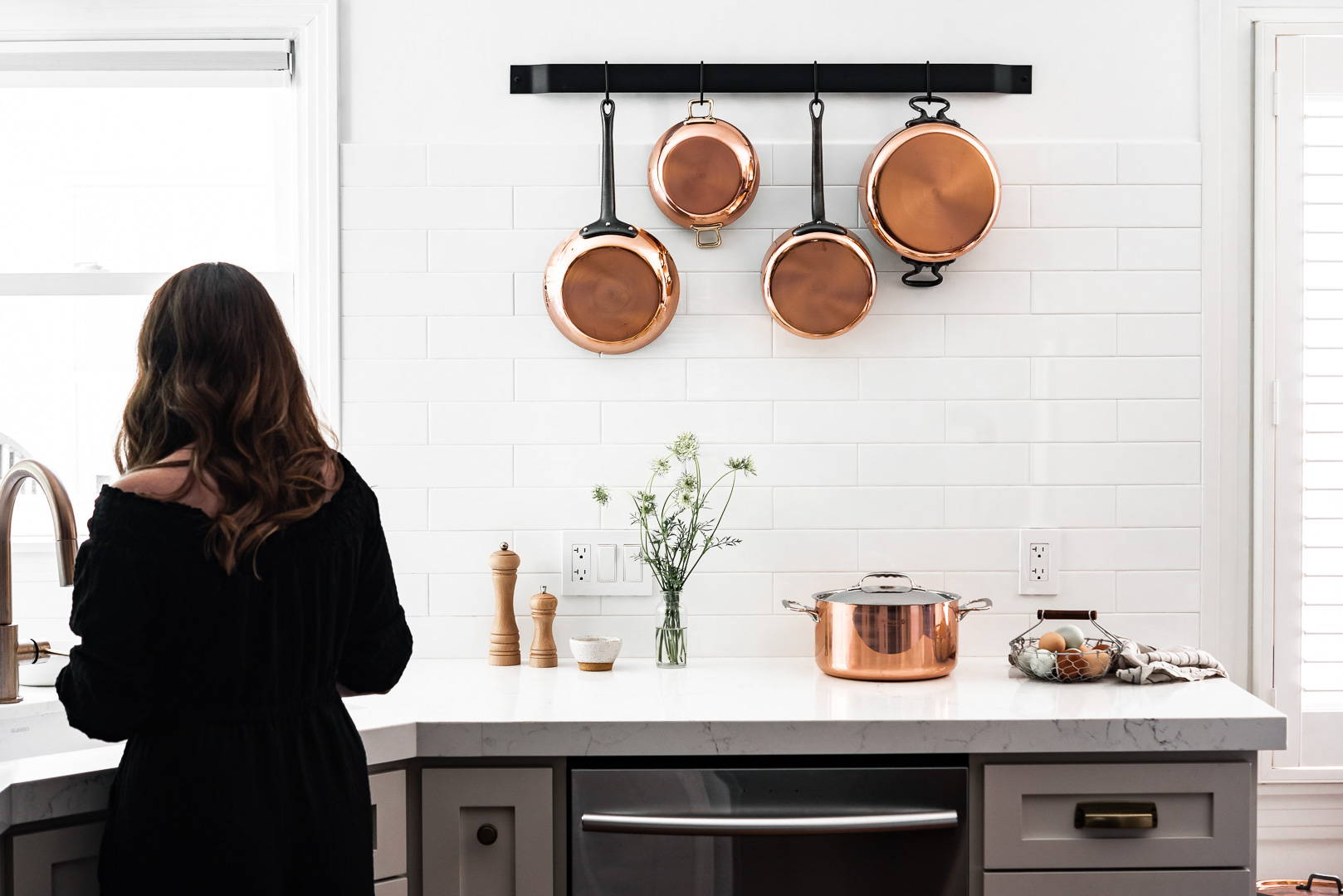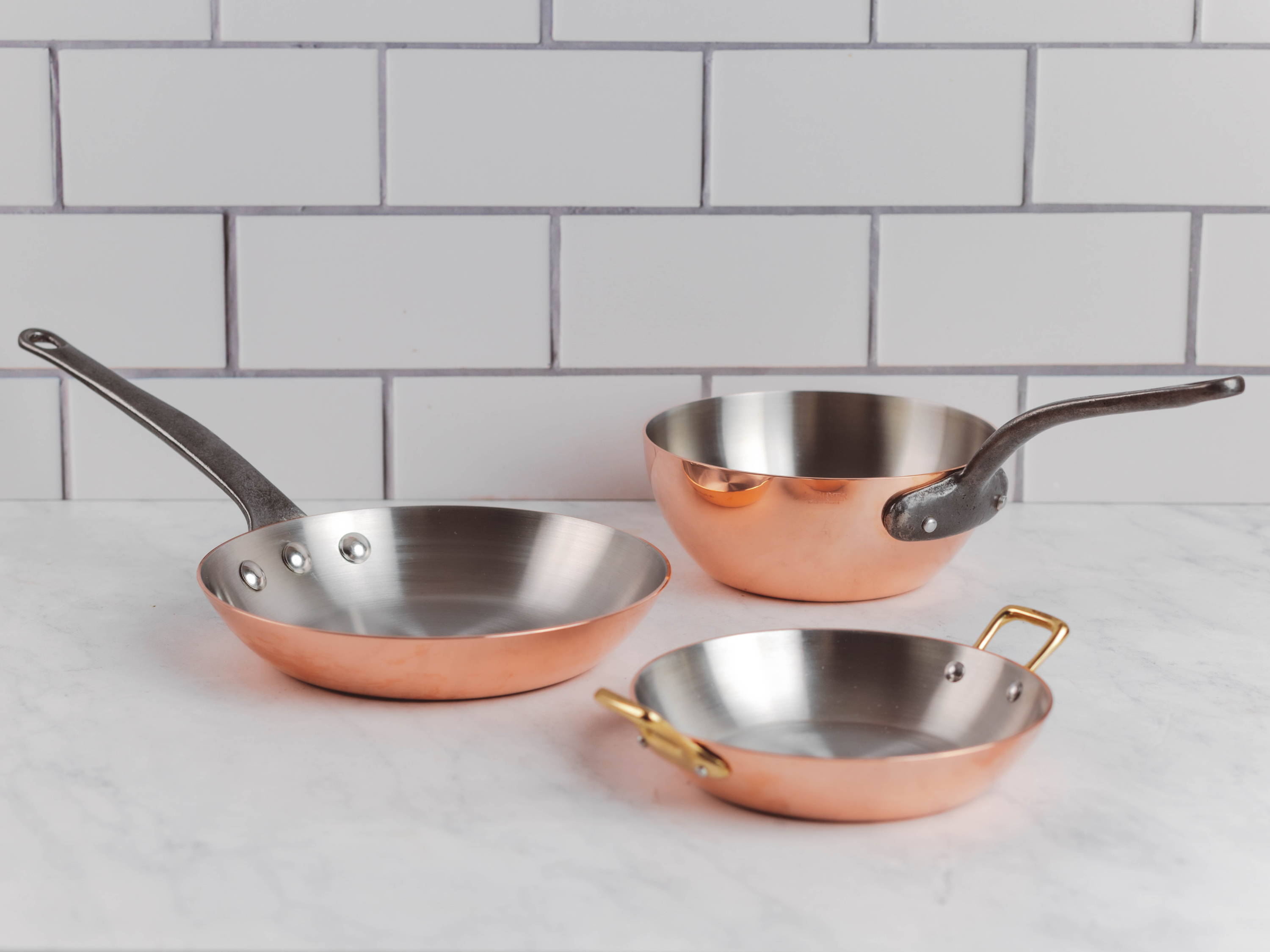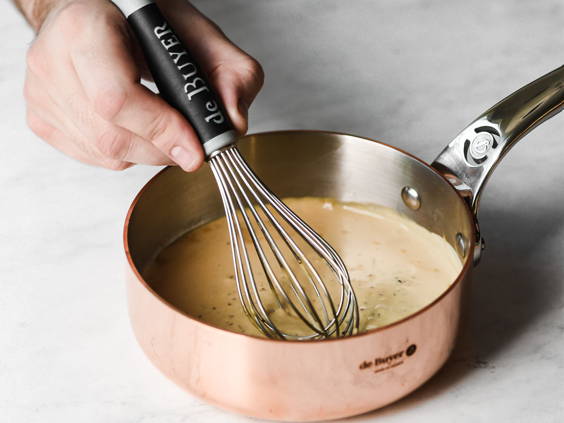If you’re debating between buying stainless steel or copper cookware, one thing is certain: you’ve got an eye for style. The reflective exterior of stainless steel, like our 5-ply AFFINITY Collection, and the brightness of copper, like the PRIMA MATERA, or INOCUIVRE collection, are certainly eye-catching when displayed in any kitchen.
Beyond their aesthetic superiority, they share additional benefits in common versus other materials. But the differences between the two are what will ultimately help you decide what’s right for the job.
Both of these materials are superior conductors of heat and highly responsive to temperature changes.
In terms of both cooking and aesthetics, they both rank at the top. Our stainless steel cookware is made from an alloy of chromium and iron, while our copper cookware is 90% copper and 10% stainless steel.
Now, let's explore the distinct characteristics and features of stainless steel and copper cookware to help you make an informed decision.

How to Decide Between Stainless Steel or Copper Cookware
Cooks love the look and the temperature control of copper. The high ratio of copper to stainless steel is what makes de Buyer copper unique, as many brands fall short, affecting the overall conductivity of the pan.
Professional kitchens appreciate the durability of stainless steel, and the way that it offers temperature control that is comparable enough to copper cookware, but without the investment.
Let's break down some of the comparisons between these two expert cooking materials.

Heat Conductivity:
Stainless Steel Thermal Conductivity:
- Conducts heat quickly and evenly
- Ideal choice for flat-top stoves
- Great for low to high temperature cooking
Although not the highest thermal conductivity, stainless steel still exhibits good heat conduction properties. Compared to metals like copper and aluminum, stainless steel has a lower thermal conductivity rating of approximately 15 watts per kelvin per meter.
However, its durability, resistance to corrosion, and versatility make it a popular choice for cookware and other applications where thermal conductivity is not the sole determining factor
Copper Thermal Conductivity:
- Offers the best heat conduction of any material
- Responds quickly to temperature changes
- Maintains thermal consistency
Copper has exceptional thermal conductivity, making it an excellent choice for cookware. Its high thermal conductivity allows for quick and even heat distribution, making it ideal for quick frying or boiling water.
However, lower thermal conductivity materials may be more suitable when it comes to slow cooking or stewing.
The Verdict:
When it comes to thermal conductivity, copper outperforms stainless steel. Copper heats up quicker and more evenly, making it suitable for quick frying or boiling water.
However, it's essential to consider other factors when choosing between copper and stainless steel cookware. While copper's high thermal conductivity benefits specific cooking techniques, it may not be ideal for stewing or slow cooking, where lower conductivity materials like stainless steel may provide better results.
Ultimately, the decision should be based on various factors, including cooking preferences, budget, and desired performance.
Ease of use:
Stainless Steel Ease of Use:
- Oven-safe
- Safe to use with induction cooktops
- No seasoning required
- Not completely non-stick, requires some getting used to
- Very durable
Stainless steel is known for its ease of use, making it a popular choice in various applications. Its smooth and non-porous surface resists sticking and is easy to clean, allowing for effortless food release and hassle-free maintenance.
Additionally, stainless steel's durability and resistance to heat, stains, and corrosion contribute to its user-friendly nature, providing a reliable and long-lasting material for everyday use.
Copper:
- Oven-safe
- No seasoning required
- PRIMA MATERA line is safe to use with induction cooktops
Copper cookware is easy to use due to its excellent heat conductivity and responsiveness to temperature changes. Its ability to distribute heat evenly allows for precise cooking control, making it ideal for quick frying or boiling tasks.
Additionally, copper cookware's natural non-stick properties and durability make it convenient and enjoyable to use in the kitchen.
The Verdict:
Both copper and stainless steel cookware are relatively easy to use since they don't require seasoning and are oven safe. However, it’s important to remember that they are not non-stick.
If induction cooktop use is a priority, choosing either stainless steel or the copper Prima Matera line is important, which is induction-compatible.
In conclusion, copper and stainless steel cookware are all excellent choices depending on personal preferences and specific cooking needs.

maintenance & Clean up:
Stainless Steel Maintenance & Clean Up:
- Easy to clean
- Dishwasher safe
- Low maintenance
- Susceptible to fingerprints and smudges
Stainless steel cookware is durable and easy to care for. Here are some critical points for caring for stainless steel:
- Hand-washing: Stainless steel cookware can be easily cleaned by hand using warm water and mild dish soap.
- Non-abrasive cleaning: Avoid using abrasive cleaners or scouring pads that can scratch the surface of stainless steel.
- Regular drying: Thoroughly dry stainless steel cookware after washing to prevent water spots and maintain its shine.
- Stainless steel cleaners: Commercial stainless steel cleaners or homemade pastes made from baking soda and water can remove stubborn stains or restore shine.
- Dishwasher safety: Dishwasher safe, but handwashing is recommended to keep your pan in it’s best shape. Continuous use of the dishwasher can lead to potential alterations of the material.
- Maintenance: While stainless steel is durable, it may develop a patina over time. Polishing with stainless steel cleaner can help maintain its appearance.
Copper Maintenance & Clean Up:
- Must be hand-washed
- Should be hand dried to prevent spotting
- Requires occasional polishing
- Susceptible to fingerprints and smudges
Copper cookware requires proper care to maintain its appearance and performance. Here are some key points for caring for copper:
- Hand-washing: Copper cookware should be gently hand-washed using warm water and mild dish soap. Avoid using abrasive cleaners or scrubbers that can scratch the surface.
- Drying: After washing, it is crucial to thoroughly dry copper cookware with a soft cloth to prevent water spots and tarnishing
- Polishing: Occasional polishing helps maintain the shiny appearance of copper. Commercial copper cleaners or homemade pastes made from lemon juice, vinegar, and salt can remove the tarnish and restore the luster.
- Preventing scratches: Since copper is a soft metal, it is important to use gentle utensils and avoid harsh scouring pads or abrasive materials that can scratch the surface
The Verdict:
In terms of maintenance and durability, stainless steel cookware is generally easier to care for and more durable than copper cookware.
While copper cookware may require more attention and maintenance, its superior heat conductivity and unique aesthetic may make it worth considering for certain individuals.
Ultimately, the choice between stainless steel and copper cookware depends on balancing the ease of care with other factors such as heat conductivity, cooking preferences, and personal preferences for appearance.
Additional Features:
Oven Safety:
- Both are oven safe on their own but are impacted by their lining
- Copper lined with tin isn’t very oven-safe and has problems at 450°F.
- Copper lined with stainless steel is better and goes up to 800°F
- Stainless steel can be anywhere between 500 to 800°F
Stainless steel cookware is generally oven-safe and can withstand high temperatures ranging from 500°F to 800°F, depending on the specific grade and construction. It provides versatility for various cooking techniques, including baking and roasting.
On the other hand, copper cookware is oven-safe up to an average of 500°F, with variations depending on the brand. It is important to check the manufacturer's instructions to ensure safe oven use with copper pans, especially considering factors like handle materials and non-stick coatings.
Induction
Induction cookware is specifically designed for induction cooktops, which rely on magnetic induction to heat the cookware directly.
Induction cookware must have a magnetic base or core that can interact with the electromagnetic field generated by the induction cooktop. This construction allows for efficient and precise heating, with the cookware heating up quickly and evenly.
- Not all cookware works with an induction stovetop. It has to be magnetic.
- Copper cookware is not usually induction compatible unless it includes other materials.
- Stainless steel can be induction compatible depending on the type. You have to check the brand to find out.
Induction cooking utilizes electromagnetic energy to heat the cookware directly, bypassing the cooktop surface. This efficient method offers rapid heating, precise temperature control, and energy efficiency.
When comparing the induction capabilities of different materials, it's essential to consider their magnetic properties. Cookware made of ferromagnetic materials, such as cast iron and some stainless steel, is highly compatible with induction cooking.
Non-ferromagnetic materials like aluminum, copper, and glass are not induction-compatible unless they have an induction-friendly layer or core.
The choice of cookware material should align with its magnetic properties for optimal performance on induction cook tops.
Take a look at de Buyer’s complete collection of cookware to fulfill your culinary dreams!
Stainless steal vs copper price
- Stainless steel is typically cheaper than copper.
- It can be under $100 dollars on the low end but much more on the high end.
Stainless steel cookware prices range from $135.00 to $450.00, offering options for different budgets and preferences.
With various collections available, customers can find high-quality stainless steel cookware that meets their needs while providing durability and performance in the kitchen.
Copper Price:
- Copper is typically much more expensive than stainless steel.
- Most copper pieces start at a few hundred dollars for each piece.
- Some pans are listed as “copper” and seem very affordable. However, these are often aluminum pans with a ceramic coating. Check how much copper is actually in the pans if the deal seems too good to be true.
Copper cookware prices vary, with the highest-priced product reaching $1,300.00. The price range reflects the quality and craftsmanship of copper cookware, making it an investment for serious chefs who value its exceptional heat distribution and performance in the kitchen.
Customers can choose from various copper cookware types, including pans, stockpots, and saucepans, to suit their cooking needs and budget.
The verdict
- Stainless steel is usually more affordable.
- You must ensure your price is worth it for the specific set/pans you are getting.
- It may be worth it to jump up in quality for either material.
Stainless steel cookware prices range from $135.00 to $450.00, while copper cookware reaches a higher price point, with the highest-priced product listed at $1,300.00.
The price difference between stainless steel and copper cookware reflects each material's distinct qualities and properties, with copper being a premium choice known for its exceptional heat conductivity and performance. In contrast, stainless steel offers durability and versatility at a more affordable price.
Best Uses:
Stainless Steel:
- For cooking food evenly food without burning it
- Great for cooking on flat-top stoves
- Browning and braising meats
- Boiling and reducing soups and sauces
- Sautéing vegetables
Stainless steel cookware is well-suited for a variety of foods and cooking tasks. Its even heat distribution makes it ideal for searing meats, sautéing vegetables, and browning ingredients.
Stainless steel is excellent for making pan sauces and deglazing, as it allows for easy scraping of browned bits. Its non-reactive nature makes it perfect for cooking acidic foods like tomato-based sauces and citrus-infused dishes.
Overall, stainless steel is a versatile option that can handle a wide range of cooking tasks with precision and reliability.
Copper:
- Delicate dishes that require controlled temperatures
- Searing and browning meat and seafood
- Cooking delicate proteins like fish and seafood
- Thickening sauces, caramels, and jams
- Soups and stews
- Acidic dishes are not the best, as it can lead to a metallic taste, unless you use lined cookware
Copper cookware excels at tasks that require precise temperature control and quick heat responsiveness. It is particularly well-suited for jobs such as sautéing, searing, and caramelizing, where even heat distribution is crucial.
Copper is also excellent for delicate tasks like making sauces, where rapid cooling is necessary. Its conductivity makes it ideal for tasks that demand quick adjustments and fine-tuning heat levels.
Overall, copper cookware is highly versatile and preferred for professional chefs and experienced home cooks who value its exceptional heat performance.

So which one should you try?
When deciding between copper and stainless steel cookware for your kitchen, there are several things to consider, including what kind of dishes you plan to cook, maintenance needs, and your budget.
Copper might be best for you if:
- You often cook delicate, French-style sauces
- You’re ok with some regular maintenance to keep your copper looking good
- You value the aesthetic beauty of copper and its ability to double as serveware
Stainless Steel might be best for you if:
- You spend most of your time cooking and need ultra-durable cookware
- You're looking for copper-like performance without a big investment
- You value the convenience of easy dishwasher clean-up
Stainless Steel vs Copper Cookware | Stainless Steel | Copper |
Appearance | Silver interior and exterior can be polished or matte | Reddish brown with silver interior |
Construction | Stainless steel interior and exterior, copper or aluminum core or base plate | Copper exterior, stainless steel or tin interior |
Durability | Very durable, scratch, dent, and warp resistant | Soft, can be easily scratched or tarnished |
Heat Conductivity | Low, heats slower than copper | High, heats quickly |
Responsiveness | Slow temperature response | Heats and cools quickly |
Oven-safe | 400 - 800℉ | 400 - 800℉ |
Induction Compatible? | Yes | Not generally, but certain lines are |
Care and Maintenance | Dishwasher or hand wash safe, low maintenance | Hand wash only, needs polishing |
Where It’s Made | Globally, De Buyer is made in France | France is the hub, but many brands are made globally; De Buyer is made in France |
Price | Wide range | Usually more expensive for quality cookware |
Main Benefits | Very durable and low maintenance | Better heat responsiveness and conduction |
Main Disadvantages | Usually food sticks, quality can vary by brand, and may be expensive | Expensive and requires more maintenance |
Look no further than de Buyer for exceptional Stainless Steel or Copper Cookware!
STAINLESS STEEL VS COPPER: LOVE YOUR COOKWARE NO MATTER YOUR CHOICE
Whether you choose stainless steel or copper, or opt for a combination of both, you’re making a great long-term investment in high-quality cookware. For serious and seasoned cooks, these materials offer the biggest bang for your buck.
At de Buyer, we take pride in crafting the highest quality of materials with artisan hands for cookware that lasts. Whether you choose our stainless steel or copper collections (or both!), you’ll love what you're cooking with.
★SHOW US HOW IT TURNED OUT★
Post a photo of the meal you made with your de Buyer products on Facebook or Instagram with the hashtag #DBrecipe ... Don’t forget to tag us! @debuyerusa
Not on socials? No problem. Send us your photo by email to dbinsider@debuyer.com
